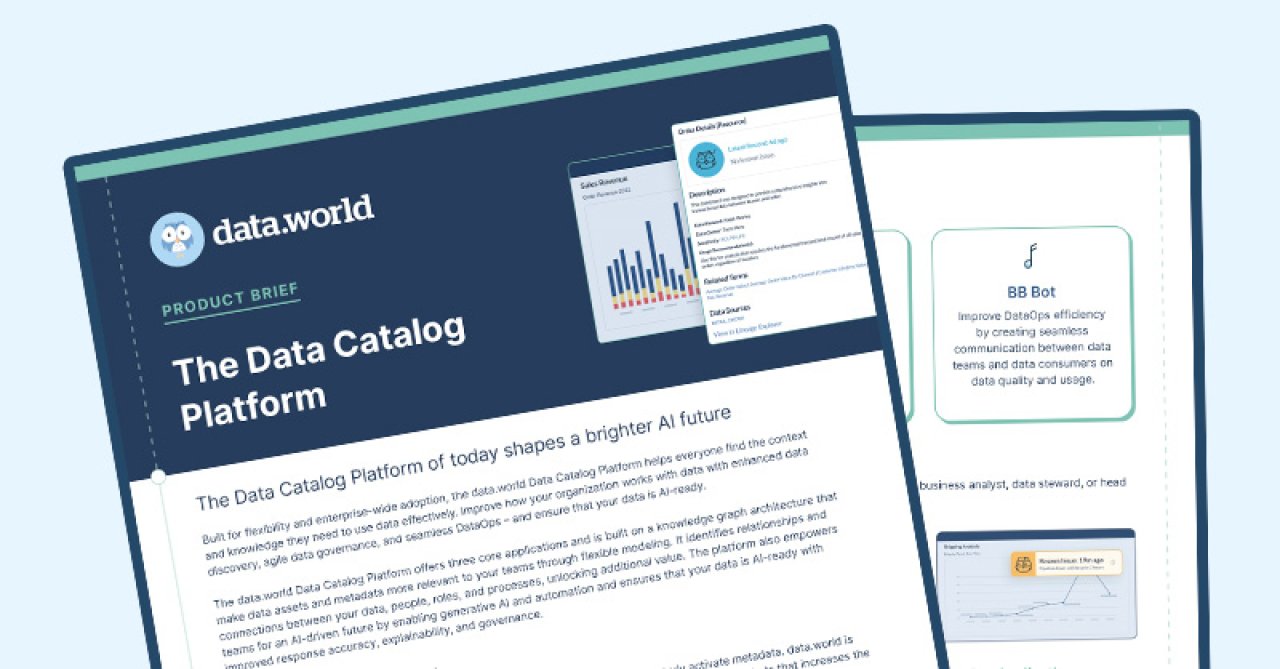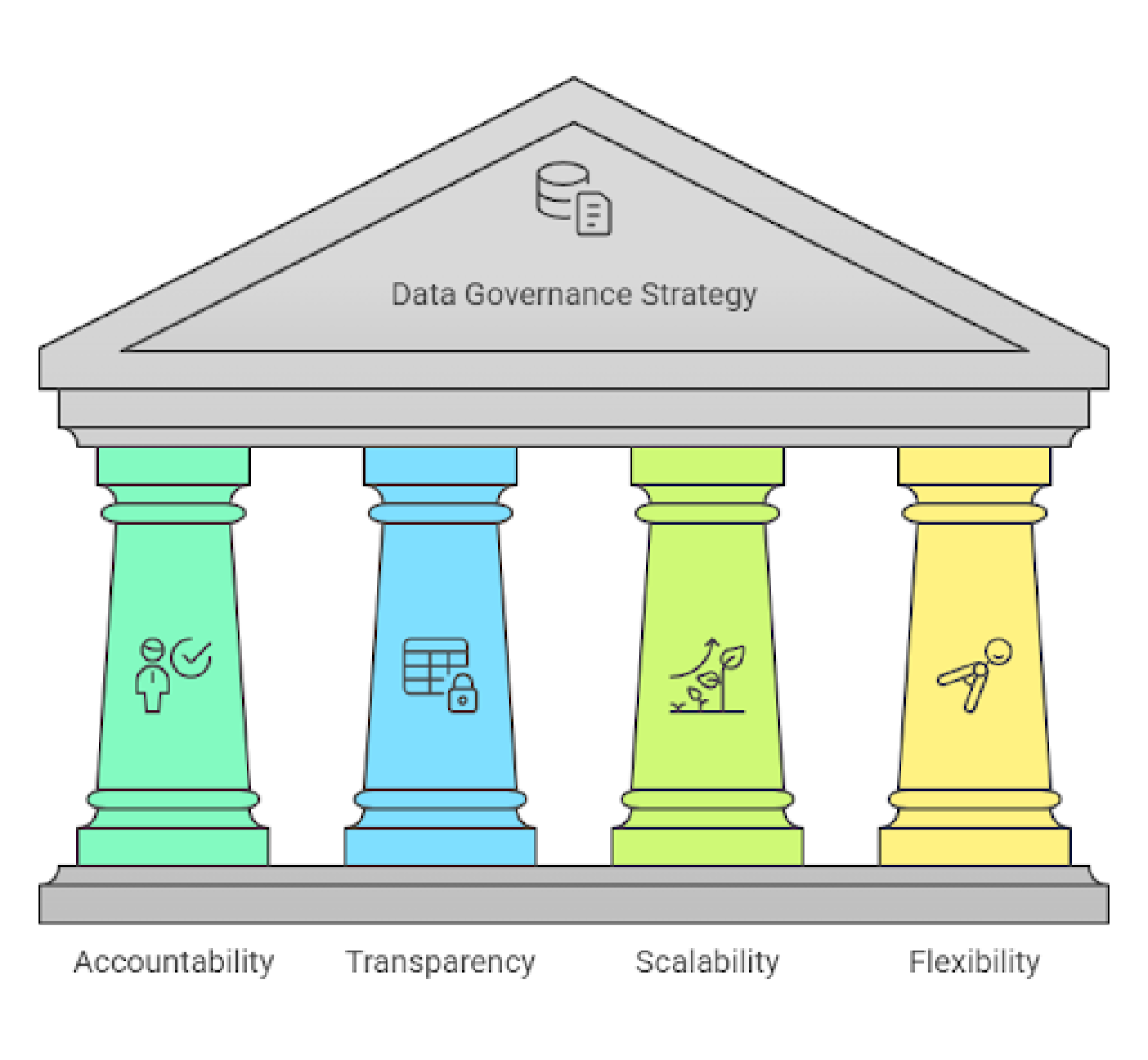







Mar 18, 2025

Liz Elfman
Content Marketing Director

Data governance is a set of practices that creates a structured framework for maintaining data quality, security, compliance, and accessibility. It prevents inconsistencies and protects data against breaches by staying compliant with regulations like GDPR and CCPA.
Governance is the foundation of an effective data strategy. It aligns data management practices with business goals to help organizations extract value from their data while minimizing risks. However, governance must balance control and agility to make sure policies do not become rigid but instead support innovation and adaptability for higher business growth.
At its core, data governance strategy is based on 4 major principles that facilitate proper data management:
Accountability: Clear roles and responsibilities must be established for data stewardship and ownership. You should define who is responsible for data accuracy and compliance to promote accountability at every level. This prevents data mismanagement and builds more trust in decision-making.
Transparency: Governance policies and data assets should be visible and accessible to relevant stakeholders as this reduces ambiguity and builds a culture of data-driven decision-making.
Scalability: As data volumes and regulations change, governance structures should be capable of expanding without disrupting operations. This scalability maintains efficiency even if business complexity increases.
Flexibility: Governance should be agile and adaptable to changing technological advancements and regulatory updates. Rigid governance models can hinder innovation, while flexible approaches help organizations adjust governance practices without slowing growth.

Traditional data governance models often fail due to rigid structures where decision-making is centralized and data access approval processes are lengthy. These models rely on strict policies and hierarchical controls, due to which data teams can’t access the needed assets at the right time.
More importantly, traditional models can’t accommodate rapid changes in technology and regulations. For example, Securitas, a multinational security services company, experienced a major data breach due to inadequate data governance practices. Approximately 1.5 million of their files containing 3 TB of data were exposed in an unsecured Amazon S3 bucket. This misconfiguration allowed unauthorized access to sensitive information related to employees and business operations.
To prevent such issues, follow an agile data governance approach, which is flexible and iterative in managing and overseeing data processes. Some of its key benefits are:
Empowers teams to make decisions at the local level, reducing bottlenecks and enabling quicker responses to emerging issues.
Encourages collaboration across departments by breaking down silos and promoting a culture of shared responsibility for data quality and compliance.
Grows with data volume, so it is easier to make incremental data adjustments rather than large-scale overhauls.
Simplifies adaption to new regulations and market demands with iterative reviews and continuous feedback loops.
Due to these benefits, agile governance is considered a dependable approach for organizations to adapt to evolving regulations and market demands.
Cisco adopted a similar agile data governance approach by integrating flexible data management strategies. This way they were able to continuously refine their data policies and practices to support rapid decision-making and innovation. It also reduced defects by 40% in their dataOps and improved Defect Removal Efficiency (DRE) by 14%. This improvement can be a major inspiration for companies planning to shift to agile approaches from rigid models.
Data catalogs are centralized platforms that manage and access an organization's data assets. They are the backbone of modern data governance strategies through which organizations utilize the full potential of their data from a single source of truth. Let’s see how they support overall data governance and strategy:
Data catalogs index and organize data assets so users can search and discover relevant datasets. They maintain proper metadata (e.g., data descriptions, tags, and ownership details) to add more context and provide details into the data's purpose and usage. This way, teams don’t waste most of their time searching for data. Instead, they focus on using those insights for faster decision-making and improving productivity.
Data catalogs track the origin and transformation of data throughout its lifecycle, or in other words it tracks data lineage. This provides enough transparency and a proper understanding of how data flows and changes over time to help data teams spot the reason behind any discrepancies. As a result, you can trace errors before they become huge issues and affect data quality.
Data is often locked within specific departments which creates silos and inconsistent definitions of key business metrics. For example, the marketing department may define customer retention differently from the finance team. As a result, they will produce conflicting reports.
A data catalog breaks down these silos by providing a shared business glossary. These glossaries help teams align on terminology so everyone speaks the same data language.
In addition, it allows teams to document insights, tag important datasets, and even crowdsource information about best practices. Instead of relying on one or two data experts to explain everything, you can build a knowledge base that grows over time.
With the rise of data privacy laws like GDPR and CCPA, organizations are under increasing pressure to strengthen data security and regulatory compliance. Data catalogs make this easier by providing granular access controls so only authorized users can view or modify sensitive data. They also maintain detailed audit trails that log all access and changes to data assets.
With these capabilities, sensitive data is protected and access is granted based on user roles and responsibilities. As a result, you can demonstrate compliance with regulations by providing a record of who accessed or modified data and when within your organization.
Now that you know the importance of data governance strategy, let’s look at how to build it step by step:
First, evaluate how your data is collected, stored, processed, and shared across the organization. This will help you identify gaps in current management practices so you can map data flows. Pinpoint areas where data is incomplete or incorrect. Then, create a visual representation of how data moves through systems and departments to understand how to improve its flow.
Now, list down data governance goals that support broader organizational objectives. Every organization has different priorities when it comes to data governance. Some are focused on regulatory compliance. Others need to improve data quality to reduce inconsistencies and errors that impact decision-making. Some want better data accessibility so teams can find and trust the right information.
Overall, your goals should be SMART (Specific, Measurable, Achievable, Relevant, and Time-bound) like improving data accuracy by 20% within 6 months. As a best practice, focus on high-impact areas like regulatory compliance or operational efficiency that require the most attention in data governance.
Once you’ve mapped your goals, create clear policies and set standards to implement procedures across your systems.
Policies define what should happen, such as access restrictions for sensitive data or retention rules for old records.
Standards maintain consistency, from how data is formatted to how it’s labeled across different systems.
Procedures detail how governance is enforced, like what happens when an employee requests access to restricted data.
But you don’t have to overcomplicate this step because governance should empower teams, not slow them down with unnecessary rules. Your goal should be to balance control and flexibility to ensure data remains usable and protected.
Identify the roles (data stewards, owners, and governance committees) and responsibilities of every data management team member. Specify how each member will maintain data quality and integrity within their specific domains.
For example, senior stakeholders who can make decisions about data usage are accountable for the datasets. Cross-functional teams should oversee governance initiatives and resolve conflicts. This way you will know that all roles have clearly defined duties and accountability.
Now if you want to enforce governance manually, let’s be real — it will be time-consuming and prone to human error. So go for tools like data catalogs as they centralize and organize metadata, which makes it easier for teams to find their data assets.
These tools offer automation features, such as AI-powered tagging and lineage tracing, to streamline data inventory processes and reduce the manual hassle of classifying data.
Take JPMorgan Chase for example — they implemented a centralized data catalog called Fusion Data Catalog to improve data discovery and lineage tracking. They now manage large amounts of financial data, customer information, market trends, and offer many more end-to-end data management capabilities.
Since governance is an ongoing process that evolves as data needs change, start with impactful changes and adjust based on feedback instead of trying to create a perfect system upfront. Here’s how you can roll out such iterative and adaptive governance practices:
Start small: Begin with a pilot project to test governance processes and gather feedback.
Engage stakeholders: Involve cross-functional teams early in the stages of strategy planning to gain their buy-in and interest in the impact of agile processes.
Iterate frequently: Use feedback loops to refine policies and processes in short cycles.
Monitor progress: Track effectiveness of your changes and identify areas for improvement with KPIs.
Scale gradually: Expand governance practices incrementally as the organization matures.
The success of a governance strategy is measured by how well it improves data usability. To calculate this, define KPIs such as data accuracy rates, compliance audit results, and time-to-resolution. They will give a broader idea of data issues and provide actionable insights into governance performance.
Review these metrics regularly to make sure governance remains a living process, not a static set of rules. And if you notice your policies aren’t driving the intended improvements, make adjustments because a data governance strategy should always serve the organization’s business needs, not just exist for its own sake.
Organizations lose nearly $12.9 million annually due to poor data quality. This shows how important modern data governance strategies are for building an agile and sustainable data management framework. But to achieve maximum efficiency in data governance, you need a trusted data catalog provider that can make all the difference.
data.world’s modern data catalog platform enables agile data governance by centralizing metadata management and automating data discovery. It offers advanced tools for collaboration and compliance to promote flexibility in your data workflows.
With features like role-based access and data lineage tracking, data.world helps organizations realize their data's full potential while staying secure and compliant.
If you're interested in upping your data strategy and governance game, book a demo with data.world.

Data governance is a set of practices that creates a structured framework for maintaining data quality, security, compliance, and accessibility. It prevents inconsistencies and protects data against breaches by staying compliant with regulations like GDPR and CCPA.
Governance is the foundation of an effective data strategy. It aligns data management practices with business goals to help organizations extract value from their data while minimizing risks. However, governance must balance control and agility to make sure policies do not become rigid but instead support innovation and adaptability for higher business growth.
At its core, data governance strategy is based on 4 major principles that facilitate proper data management:
Accountability: Clear roles and responsibilities must be established for data stewardship and ownership. You should define who is responsible for data accuracy and compliance to promote accountability at every level. This prevents data mismanagement and builds more trust in decision-making.
Transparency: Governance policies and data assets should be visible and accessible to relevant stakeholders as this reduces ambiguity and builds a culture of data-driven decision-making.
Scalability: As data volumes and regulations change, governance structures should be capable of expanding without disrupting operations. This scalability maintains efficiency even if business complexity increases.
Flexibility: Governance should be agile and adaptable to changing technological advancements and regulatory updates. Rigid governance models can hinder innovation, while flexible approaches help organizations adjust governance practices without slowing growth.

Traditional data governance models often fail due to rigid structures where decision-making is centralized and data access approval processes are lengthy. These models rely on strict policies and hierarchical controls, due to which data teams can’t access the needed assets at the right time.
More importantly, traditional models can’t accommodate rapid changes in technology and regulations. For example, Securitas, a multinational security services company, experienced a major data breach due to inadequate data governance practices. Approximately 1.5 million of their files containing 3 TB of data were exposed in an unsecured Amazon S3 bucket. This misconfiguration allowed unauthorized access to sensitive information related to employees and business operations.
To prevent such issues, follow an agile data governance approach, which is flexible and iterative in managing and overseeing data processes. Some of its key benefits are:
Empowers teams to make decisions at the local level, reducing bottlenecks and enabling quicker responses to emerging issues.
Encourages collaboration across departments by breaking down silos and promoting a culture of shared responsibility for data quality and compliance.
Grows with data volume, so it is easier to make incremental data adjustments rather than large-scale overhauls.
Simplifies adaption to new regulations and market demands with iterative reviews and continuous feedback loops.
Due to these benefits, agile governance is considered a dependable approach for organizations to adapt to evolving regulations and market demands.
Cisco adopted a similar agile data governance approach by integrating flexible data management strategies. This way they were able to continuously refine their data policies and practices to support rapid decision-making and innovation. It also reduced defects by 40% in their dataOps and improved Defect Removal Efficiency (DRE) by 14%. This improvement can be a major inspiration for companies planning to shift to agile approaches from rigid models.
Data catalogs are centralized platforms that manage and access an organization's data assets. They are the backbone of modern data governance strategies through which organizations utilize the full potential of their data from a single source of truth. Let’s see how they support overall data governance and strategy:
Data catalogs index and organize data assets so users can search and discover relevant datasets. They maintain proper metadata (e.g., data descriptions, tags, and ownership details) to add more context and provide details into the data's purpose and usage. This way, teams don’t waste most of their time searching for data. Instead, they focus on using those insights for faster decision-making and improving productivity.
Data catalogs track the origin and transformation of data throughout its lifecycle, or in other words it tracks data lineage. This provides enough transparency and a proper understanding of how data flows and changes over time to help data teams spot the reason behind any discrepancies. As a result, you can trace errors before they become huge issues and affect data quality.
Data is often locked within specific departments which creates silos and inconsistent definitions of key business metrics. For example, the marketing department may define customer retention differently from the finance team. As a result, they will produce conflicting reports.
A data catalog breaks down these silos by providing a shared business glossary. These glossaries help teams align on terminology so everyone speaks the same data language.
In addition, it allows teams to document insights, tag important datasets, and even crowdsource information about best practices. Instead of relying on one or two data experts to explain everything, you can build a knowledge base that grows over time.
With the rise of data privacy laws like GDPR and CCPA, organizations are under increasing pressure to strengthen data security and regulatory compliance. Data catalogs make this easier by providing granular access controls so only authorized users can view or modify sensitive data. They also maintain detailed audit trails that log all access and changes to data assets.
With these capabilities, sensitive data is protected and access is granted based on user roles and responsibilities. As a result, you can demonstrate compliance with regulations by providing a record of who accessed or modified data and when within your organization.
Now that you know the importance of data governance strategy, let’s look at how to build it step by step:
First, evaluate how your data is collected, stored, processed, and shared across the organization. This will help you identify gaps in current management practices so you can map data flows. Pinpoint areas where data is incomplete or incorrect. Then, create a visual representation of how data moves through systems and departments to understand how to improve its flow.
Now, list down data governance goals that support broader organizational objectives. Every organization has different priorities when it comes to data governance. Some are focused on regulatory compliance. Others need to improve data quality to reduce inconsistencies and errors that impact decision-making. Some want better data accessibility so teams can find and trust the right information.
Overall, your goals should be SMART (Specific, Measurable, Achievable, Relevant, and Time-bound) like improving data accuracy by 20% within 6 months. As a best practice, focus on high-impact areas like regulatory compliance or operational efficiency that require the most attention in data governance.
Once you’ve mapped your goals, create clear policies and set standards to implement procedures across your systems.
Policies define what should happen, such as access restrictions for sensitive data or retention rules for old records.
Standards maintain consistency, from how data is formatted to how it’s labeled across different systems.
Procedures detail how governance is enforced, like what happens when an employee requests access to restricted data.
But you don’t have to overcomplicate this step because governance should empower teams, not slow them down with unnecessary rules. Your goal should be to balance control and flexibility to ensure data remains usable and protected.
Identify the roles (data stewards, owners, and governance committees) and responsibilities of every data management team member. Specify how each member will maintain data quality and integrity within their specific domains.
For example, senior stakeholders who can make decisions about data usage are accountable for the datasets. Cross-functional teams should oversee governance initiatives and resolve conflicts. This way you will know that all roles have clearly defined duties and accountability.
Now if you want to enforce governance manually, let’s be real — it will be time-consuming and prone to human error. So go for tools like data catalogs as they centralize and organize metadata, which makes it easier for teams to find their data assets.
These tools offer automation features, such as AI-powered tagging and lineage tracing, to streamline data inventory processes and reduce the manual hassle of classifying data.
Take JPMorgan Chase for example — they implemented a centralized data catalog called Fusion Data Catalog to improve data discovery and lineage tracking. They now manage large amounts of financial data, customer information, market trends, and offer many more end-to-end data management capabilities.
Since governance is an ongoing process that evolves as data needs change, start with impactful changes and adjust based on feedback instead of trying to create a perfect system upfront. Here’s how you can roll out such iterative and adaptive governance practices:
Start small: Begin with a pilot project to test governance processes and gather feedback.
Engage stakeholders: Involve cross-functional teams early in the stages of strategy planning to gain their buy-in and interest in the impact of agile processes.
Iterate frequently: Use feedback loops to refine policies and processes in short cycles.
Monitor progress: Track effectiveness of your changes and identify areas for improvement with KPIs.
Scale gradually: Expand governance practices incrementally as the organization matures.
The success of a governance strategy is measured by how well it improves data usability. To calculate this, define KPIs such as data accuracy rates, compliance audit results, and time-to-resolution. They will give a broader idea of data issues and provide actionable insights into governance performance.
Review these metrics regularly to make sure governance remains a living process, not a static set of rules. And if you notice your policies aren’t driving the intended improvements, make adjustments because a data governance strategy should always serve the organization’s business needs, not just exist for its own sake.
Organizations lose nearly $12.9 million annually due to poor data quality. This shows how important modern data governance strategies are for building an agile and sustainable data management framework. But to achieve maximum efficiency in data governance, you need a trusted data catalog provider that can make all the difference.
data.world’s modern data catalog platform enables agile data governance by centralizing metadata management and automating data discovery. It offers advanced tools for collaboration and compliance to promote flexibility in your data workflows.
With features like role-based access and data lineage tracking, data.world helps organizations realize their data's full potential while staying secure and compliant.
If you're interested in upping your data strategy and governance game, book a demo with data.world.